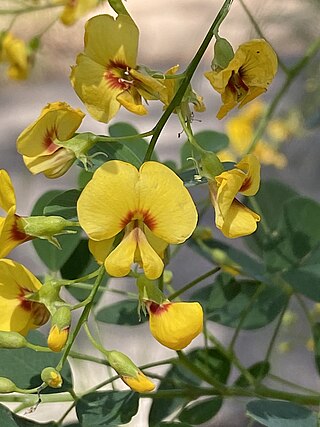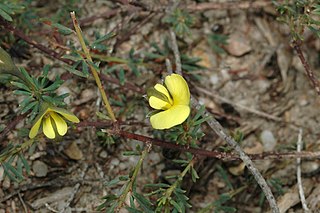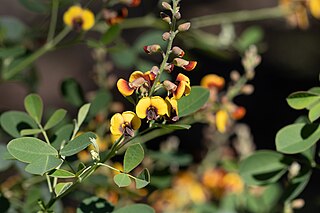
Swainsona galegifolia commonly known as smooth Darling pea, is a species of flowering plant in the family Fabaceae and is endemic to Australia. It is a small shrub with greyish-green leaves and flowers in white, red, pink, purple, yellow or orange.

Goodia is a genus of six species of flowering plants in the family Fabaceae, and is endemic to Australia. Plants in the genus Goodia are shrubs with trifoliate leaves. The flowers are arranged in racemes, the sepals with two "lips", the standard petal more or less circular and the fruit is a flattened pod.

Kennedia nigricans, commonly known as black kennedia, is a species of flowering plant in the family Fabaceae and is endemic to the south-west of Western Australia. It is a trailing or twining shrub or climber with trifoliate leaves and black and yellow-orange flowers.

Kennedia prostrata, commonly known as running postman, scarlet coral pea or scarlet runner, is a species of flowering plant in the family Fabaceae and is endemic to Australia. It is a prostrate or twining shrub with trifoliate leaves and, usually, red flowers.

Gompholobium ecostatum, commonly known as dwarf wedge-pea, is a species of flowering plant in the family Fabaceae and is endemic to southern Australia. It is a low-lying to erect shrub with trifoliate leaves with linear to lance-shaped leaflets, and apricot-coloured to reddish, sometimes yellow flowers.

Grevillea jephcottii, commonly known as Pine Mountain grevillea, green grevillea or Jephcotts grevillea is a species of flowering plant in the family Proteaceae and is endemic to a restricted area of Victoria. It is a low dense, to tall spindly shrub with narrowly oblong to narrowly elliptic leaves, and clusters of pale lemon or greenish flowers with a purplish style.

Hovea montana, commonly known as alpine hovea, mountain hovea or alpine rusty-pods, is a flowering plant in the family Fabaceae, and is endemic to Australia. It is a small shrub with narrow leaves and purple pea flowers.

Acronychia pubescens, commonly known as hairy acronychia or hairy aspen, is a species of tall shrub or small tree that is endemic to eastern Australia. It usually has trifoliate leaves, rarely simple leaves, groups of whitish flowers in leaf axils and creamy to yellowish, elliptical to spherical fruit.
Bossiaea vombata, commonly known as wombat bossiaea, is a species of flowering plant in the family Fabaceae and is endemic to the Wombat State Forest in Victoria, Australia. It is an erect shrub with flattened cladodes and yellow, pea-like flowers.

Goodia lotifolia, commonly known as golden tip or clover tree, is a species of flowering plant in the family Fabaceae and is endemic to eastern Australia. It is a sometimes tall shrub with trifoliate leaves, the leaflets narrowly egg-shaped with the narrower end towards the base, and bright yellow, pea-like flowers with red or brown markings.

Kennedia lateritia, commonly known as Augusta kennedia, is a species of flowering plant in the family Fabaceae and is endemic to the south-west of Western Australia. It is a woody climber with twining stems, trifoliate leaves and orange-red and yellow flowers arranged in groups of up to twenty-four.

Cyanothamnus nanus, commonly known as the dwarf boronia or small boronia is a plant in the citrus family Rutaceae and is endemic to eastern Australia. It is a prostrate or low spreading shrub with simple or three-part leaves and white or pale pink four-petalled flowers.

Boronia adamsiana, commonly known as Barbalin boronia, is a plant in the citrus family, Rutaceae and is endemic to a small area in the south-west of Western Australia. It is an erect, hairy shrub with trifoliate leaves and pink or white, four-petalled flowers.

Gompholobium aspalathoides is a species of flowering plant in the family Fabaceae and is endemic to eastern Australia. It is an erect, more or less glabrous shrub with trifoliate leaves with linear to narrow elliptic leaflets, and yellow pea-like flowers.

Gompholobium inconspicuum, commonly known as creeping wedge-pea is a species of flowering plant in the family Fabaceae and is endemic to south-eastern continental Australia. It is a prostrate or low-lying shrub with trifoliate leaves and pale lemon yellow to yellowish green, pea-like flowers.
Hovea corrickiae, is a species of flowering plant in the family Fabaceae and is endemic to south-eastern Australia. It is a shrub or slender tree with densely hairy branchlets, narrowly egg-shaped or elliptic, dark green leaves with stipules at the base, and mostly pale to deep mauve, pea-like flowers.
Pomaderris virgata, commonly known as upright pomaderris, is a species of flowering plant in the family Rhamnaceae and is endemic to south-eastern continental Australia. It is an erect, slender shrub with hairy branchlets, lance-shaped, narrowly elliptic or oblong leaves, and dense panicles of golden-yellow flowers.
Goodia macrocarpa is a species of flowering plant in the family Fabaceae and is endemic to eastern Australia. It is a shrub with trifoliate leaves, the leaflets narrowly elliptic to elliptic, and bright yellow and red pea-like flowers.

Goodia medicaginea, commonly known as western golden tip, is a species of flowering plant in the family Fabaceae and is endemic to southern continental Australia. It is a shrub with trifoliate leaves, the leaflets narrowly egg-shaped with the narrower end towards the base, and mostly yellow, pea-like flowers with red to purplish-black or brown markings.
Goodia parviflora is a species of flowering plant in the family Fabaceae and is endemic to Queensland. It is a shrub with trifoliate leaves, the leaflets elliptic to more or less round, and yellow or orange-yellow and red and purplish, pea-like flowers.















